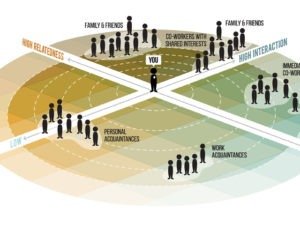If your employee engagement strategy isn’t optimized for building relationships at work, odds are it won’t be very effective.
The data connecting strong relationships between coworkers and higher engagement outputs is commonly observed, yet perplexingly unacknowledged by leaders when it comes time to actually improve scores.
But here’s what the data tells us.
Since the ‘90s, Gallup has observed a strong correlation between relationships with coworkers and employee engagement. This relationship is so significant that the organization lists having a “best friend at work” as one of the 12 necessary elements for engagement. Gallup is not alone in its research.
This link was recently corroborated by the Society for Human Resource Management. In the organization’s 2016 Employee Job Satisfaction and Engagement report, relationships with coworkers are the top driver of employee engagement.
Unsurprisingly, the stronger the relationships between coworkers, the greater the outcomes. Gallup’s research shows that although 30% of employees report having a best friend at work, this population is a whopping seven times more likely to be engaged in their jobs.
But with a workforce that now spans five generations–each with vastly different upbringings–building relationships at work is easier said than done. A nuanced, multi-pronged approach is necessary to build and strengthen bonds that transcend generational differences. Here are a few places to start:
1. Gather employee input
Stumped trying to figure out the best communication channels for your team of Millennials, Gen Xers, and Boomers to connect with? The best way to get your cross-generational teams aligned on communication is to ask them how they prefer to communicate. Yes, just ask. But then actually listen to what they tell you. Leverage their input and preferred channels to create connections that reinforce your culture. Everyone wants to feel heard and by implementing their preferences, you can make that happen across future team communication.
2. Live the culture
Your corporate core values should be held closely by employees, but they’ll still need a template for how to act on them. It’s not enough to say you want a high-performing, positive culture. You have to live it. Starting with your leaders, establish patterns of behavior that emphasize what it means to act on your unique cultural values. If you are consistent and genuine in your practice, it will inform all employee interactions, including the ways they start building relationships at work.
3. Create opportunities for face-to-face interaction
Face-to-face interactions are a vital ingredient for building relationships at work. But these work interactions need to be about more than just, well, work. Every time employees take a moment to check in with each other–at the water cooler, the break room, or even their desks–the work community grows a little tighter. Consider the ways you can thoughtfully rearrange your physical office spaces to encourage more face-to-face interaction. And people with remote employment arrangements need not be left out, either. Leverage technology like video conferencing solutions to help bridge this social distance.
4. Facilitate frequent peer-to-peer recognition
Empowering employees to consistently and frequently recognize each other’s progress and achievements strengthens bonds between individuals and improves team camaraderie. Building a culture of peer recognition has several other benefits, such as employees who are three times more engaged than those motivated by external rewards alone. To build professional relationships and increase engagement, start prioritizing micro-recognition over a top-down, macro-recognition approach.
Related: How to Engage Employees from All 5 Generations
5. Form cross-generational teams
Create opportunities for members of different generations to interact and work together. Whether it’s for a specific project or a team formed to spearhead an internal initiative, consider developing employee groups around common interests. Not only can these cross-generational teams provide a foundation for building relationships at work, they can also lead to powerful mentor-mentee sponsorships.
6. Implement social technology for building relationships at work
With the explosion of mobile-first, digital communications channels in our personal lives, there’s a growing need to see similar technologies implemented in the office. These social tools are an indispensable part of the way we build and maintain relationships in the modern world. While more social team communication tools are not a replacement for face-to-face interactions, they play a valuable role in building relationships at work. That role is one organizations desperately need to embrace. Younger generations increasingly view social technology as a work necessity, not a nice-to-have.
An organization must be laced with strong interpersonal connections across a diverse workforce if it is to endure the hypercompetitive, fast-paced future of work. Take a proactive approach to avoid an undesirable outcome. Leverage the above tips to energize employees into building relationships at work that motivate, inspire, and engage.



 3 min
3 min




